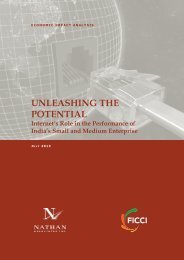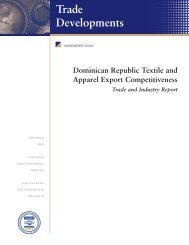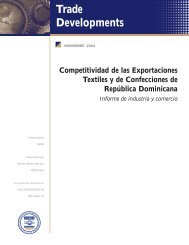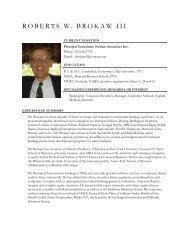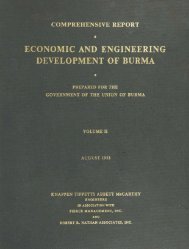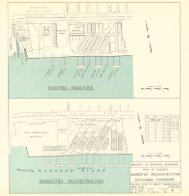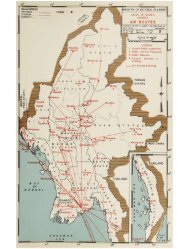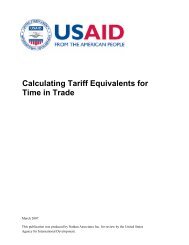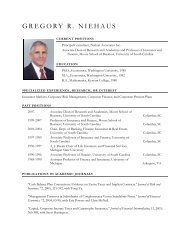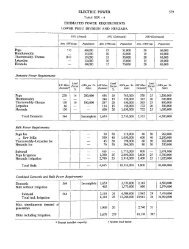Putting it to Work in Developing Countries - Nathan Associates
Putting it to Work in Developing Countries - Nathan Associates
Putting it to Work in Developing Countries - Nathan Associates
Create successful ePaper yourself
Turn your PDF publications into a flip-book with our unique Google optimized e-Paper software.
lower-tech manufactur<strong>in</strong>g they will move up <strong>to</strong><br />
more sophisticated, knowledge- and cap<strong>it</strong>albased<br />
activ<strong>it</strong>ies, leav<strong>in</strong>g the former <strong>to</strong> other FDI<br />
dest<strong>in</strong>ations that are still cost-effective. Lowertech<br />
manufactur<strong>in</strong>g opportun<strong>it</strong>ies will dw<strong>in</strong>dle<br />
as high-tech opportun<strong>it</strong>ies <strong>in</strong>crease, giv<strong>in</strong>g countries<br />
an <strong>in</strong>centive <strong>to</strong> climb the ladder and attract<br />
technology-based manufactur<strong>in</strong>g FDI. Second,<br />
as always, host countries along the ladder will<br />
need <strong>to</strong> develop packages of skills, costs, <strong>in</strong>st<strong>it</strong>utions,<br />
and policies <strong>to</strong> compete for manufactur<strong>in</strong>g<br />
FDI.<br />
FUTURE FDI DIRECTIONS—<br />
OTHER DRIVERS<br />
The forces at work <strong>in</strong> services and manufactur<strong>in</strong>g<br />
are broad, long-term determ<strong>in</strong>ants of the<br />
physical and sec<strong>to</strong>r dest<strong>in</strong>ations of FDI <strong>in</strong> the<br />
develop<strong>in</strong>g world. But four narrowly focused<br />
fac<strong>to</strong>rs will also drive patterns <strong>in</strong> FDI over the<br />
next decade or so: the phase-out of global textile<br />
quotas, the endur<strong>in</strong>g appeal of Ch<strong>in</strong>a as a dest<strong>in</strong>ation,<br />
private <strong>in</strong>vestment <strong>in</strong> <strong>in</strong>frastructure, and<br />
South–South flows of <strong>in</strong>vestment.<br />
THE END OF GLOBAL TEXTILE QUOTAS<br />
Apparel is a special case <strong>in</strong> the future of manufactur<strong>in</strong>g<br />
FDI. For nearly half a century, developed<br />
countries regulated access <strong>to</strong> their textile<br />
and apparel markets w<strong>it</strong>h import quotas, tariffs,<br />
and systems of preferential access. The<br />
Multifibre Arrangement (MFA) was the pr<strong>in</strong>cipal<br />
mechanism of control. While the agreement<br />
restra<strong>in</strong>ed imports from many low-cost producers<br />
such as Ch<strong>in</strong>a and India, <strong>it</strong> encouraged<br />
<strong>in</strong>vestment <strong>in</strong> countries that had not filled their<br />
quotas and which, <strong>in</strong> effect, enjoyed guaranteed<br />
access <strong>to</strong> U.S. and European markets. Quota<br />
access re<strong>in</strong>forced by low wages became a powerful<br />
lure for FDI <strong>in</strong> the apparel sec<strong>to</strong>r, which can<br />
establish, uproot, and repos<strong>it</strong>ion facil<strong>it</strong>ies quickly<br />
and cheaply. Many U.S., European, and Asian<br />
textile and cloth<strong>in</strong>g manufacturers set up operations<br />
<strong>in</strong> Maur<strong>it</strong>ius, Lesotho, the Caribbean,<br />
Cambodia, Mongolia and other locations that<br />
had no textile or apparel <strong>in</strong>dustry.<br />
But the system has changed radically. The WTO<br />
Agreement on Textiles and Cloth<strong>in</strong>g, <strong>in</strong> operation<br />
s<strong>in</strong>ce 1995, ended the MFA and elim<strong>in</strong>ated<br />
quotas on January 1, 2005. Many develop<strong>in</strong>g<br />
countries that had benef<strong>it</strong>ed from quota<br />
restra<strong>in</strong>ts on their <strong>to</strong>ughest rivals are now compet<strong>in</strong>g<br />
for markets <strong>in</strong> the Un<strong>it</strong>ed States and the<br />
European Union on the basis of price, qual<strong>it</strong>y,<br />
and responsiveness <strong>to</strong> market demand.<br />
How will the elim<strong>in</strong>ation of quotas affect FDI<br />
<strong>in</strong>flows As quota access becomes irrelevant <strong>to</strong><br />
plant location, many develop<strong>in</strong>g countries risk<br />
significant loss of domestic as well as foreign<br />
<strong>in</strong>vestment <strong>in</strong> textile and apparel manufactur<strong>in</strong>g.<br />
<strong>Countries</strong> such as Lesotho (textiles and apparel<br />
account for 87 percent of export value),<br />
Cambodia (84 percent), Maur<strong>it</strong>ius (57 percent),<br />
and the Dom<strong>in</strong>ican Republic (51 percent),<br />
whose <strong>in</strong>dustries have been fueled by FDI and<br />
have depended largely on quota restrictions on<br />
low-cost Asian producers, could face rapid dis<strong>in</strong>vestment.<br />
8 The full consequences of the end of<br />
the MFA are still uncerta<strong>in</strong>, but the major beneficiary<br />
will be Ch<strong>in</strong>a. Though not the lowestcost<br />
producer, Ch<strong>in</strong>a is extremely efficient<br />
because of massive economies of scale and will<br />
be able <strong>to</strong> dom<strong>in</strong>ate the <strong>in</strong>dustry thanks <strong>to</strong> <strong>it</strong>s<br />
production volume, reliabil<strong>it</strong>y, and full-package<br />
responsiveness. 9 Ch<strong>in</strong>a could garner a steadily<br />
<strong>in</strong>creas<strong>in</strong>g share of textile and apparel <strong>in</strong>dustry<br />
FDI that would have gone <strong>to</strong> other locations<br />
under the MFA regime.<br />
The <strong>in</strong>dustry, however, will seek some diversification<br />
of supply beyond Ch<strong>in</strong>a, especially<br />
among producers who modernize, ensure qual<strong>it</strong>y,<br />
and provide special advantages. FDI might<br />
still flow <strong>to</strong> countries like the Dom<strong>in</strong>ican<br />
Republic, which offers just-<strong>in</strong>-time <strong>in</strong>ven<strong>to</strong>ry<br />
advantages for the U.S. market, or <strong>to</strong> Croatia,<br />
which produces high-end specialty apparel for<br />
the EU market. 10 Bulgaria has reportedly been<br />
able <strong>to</strong> reta<strong>in</strong> FDI <strong>in</strong> textiles and apparel by<br />
upgrad<strong>in</strong>g from simple assembly <strong>to</strong> higher valueadded<br />
activ<strong>it</strong>ies. 11 Free trade agreements, such as<br />
CAFTA between the Un<strong>it</strong>ed States and the<br />
Dom<strong>in</strong>ican Republic and Central American<br />
49



